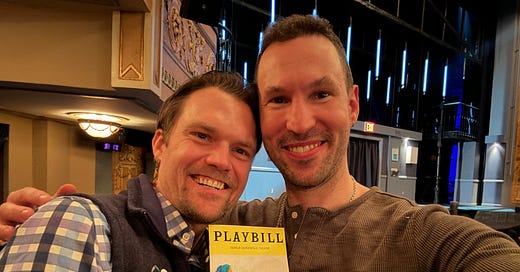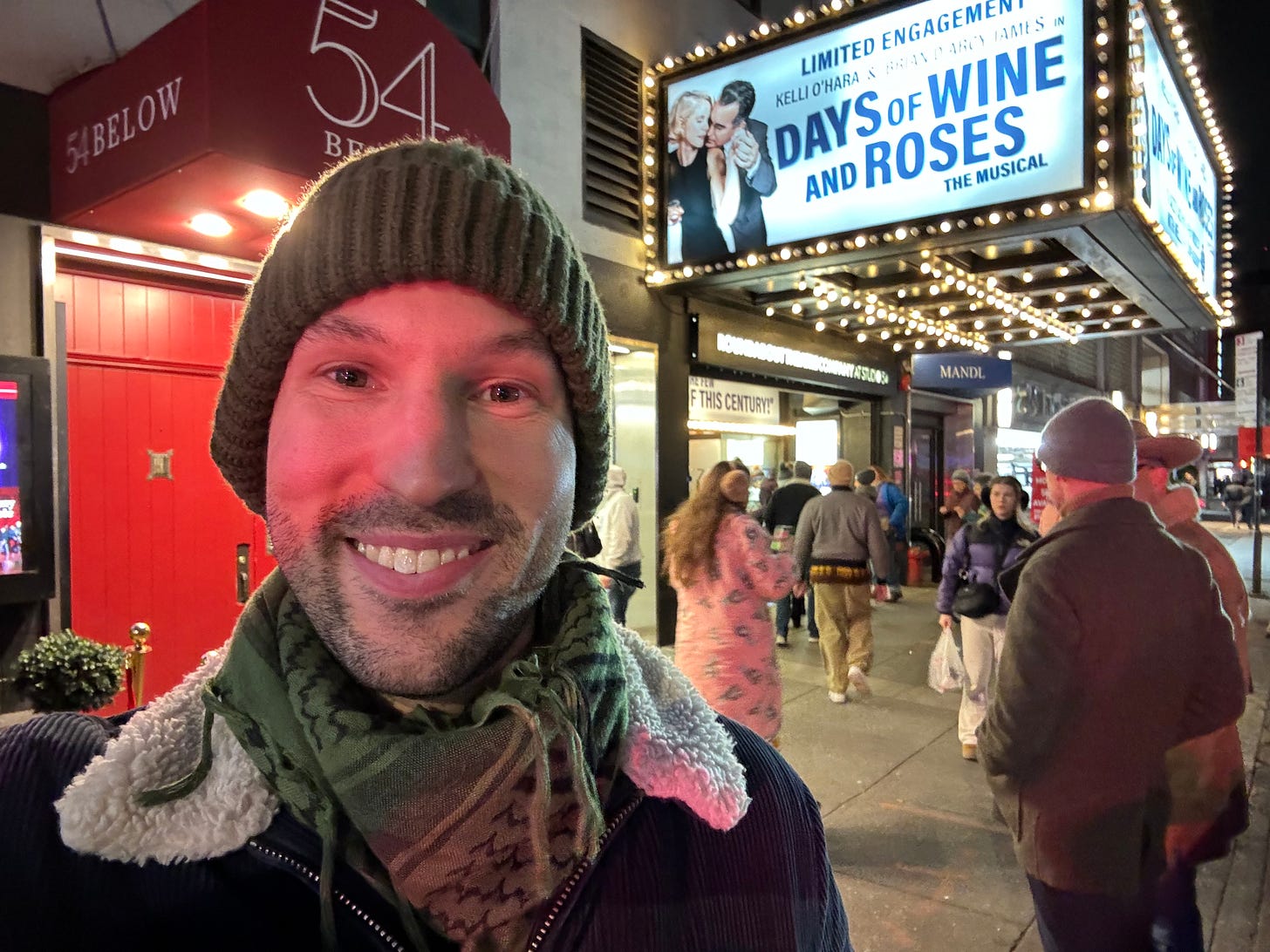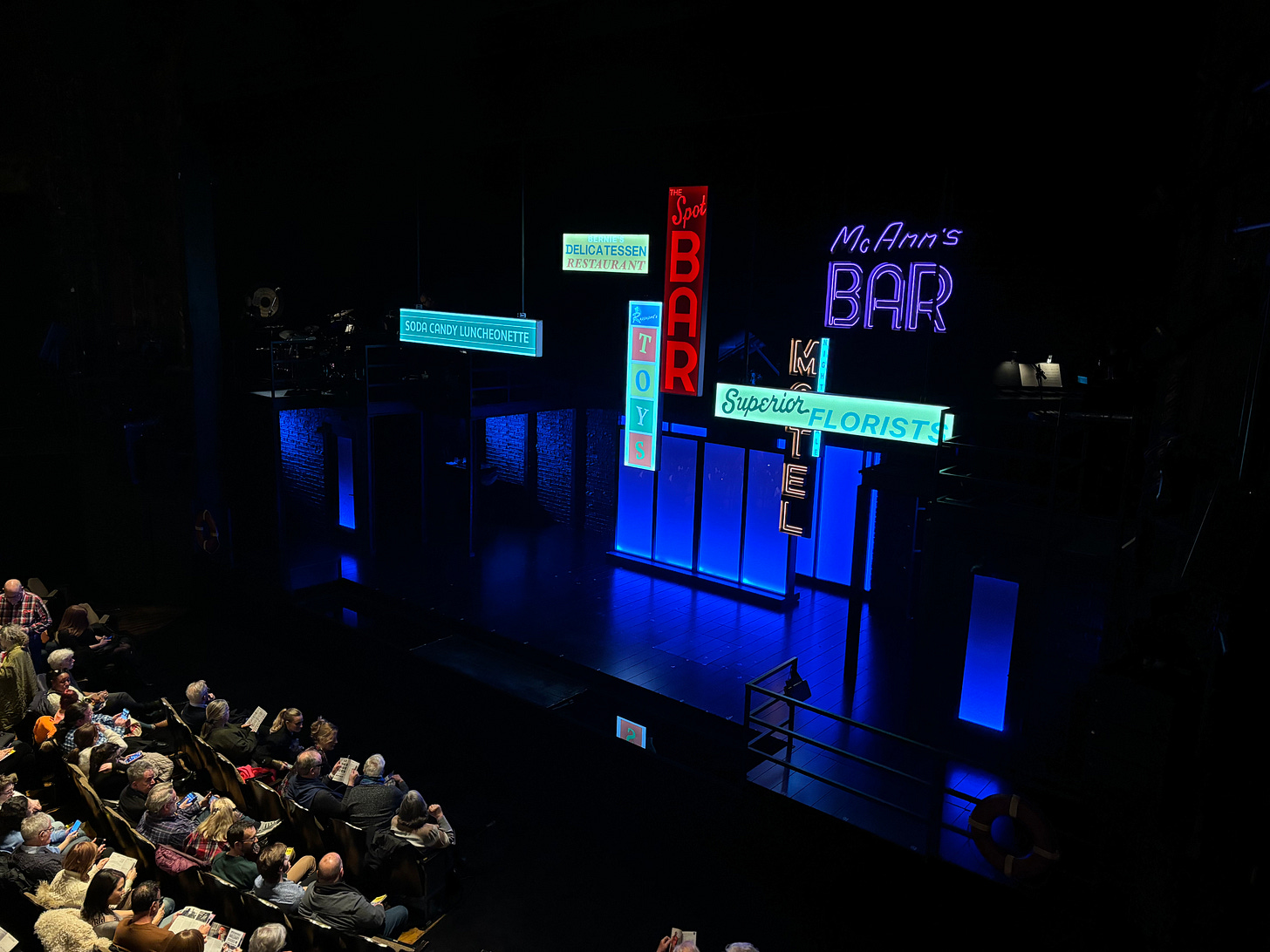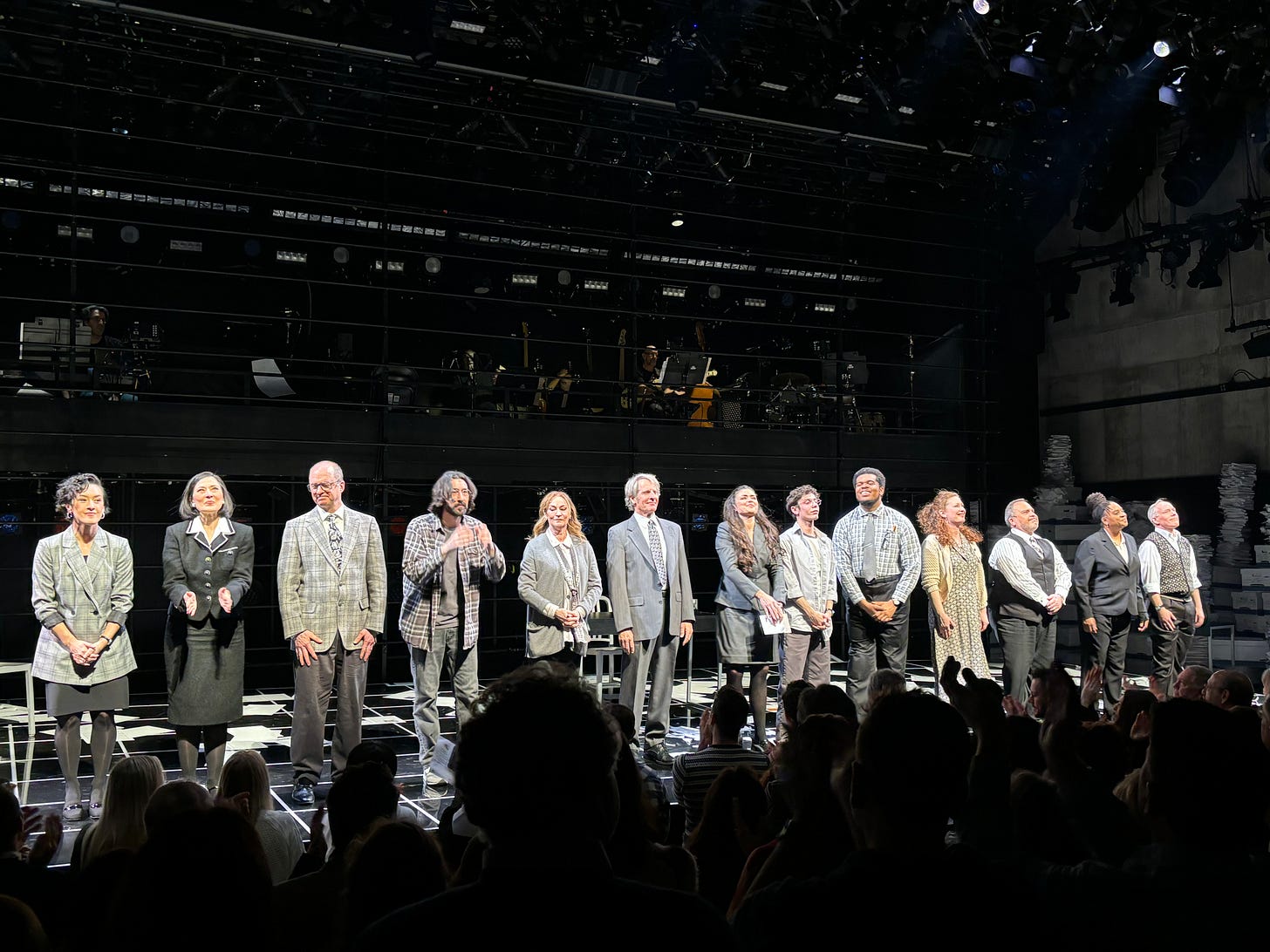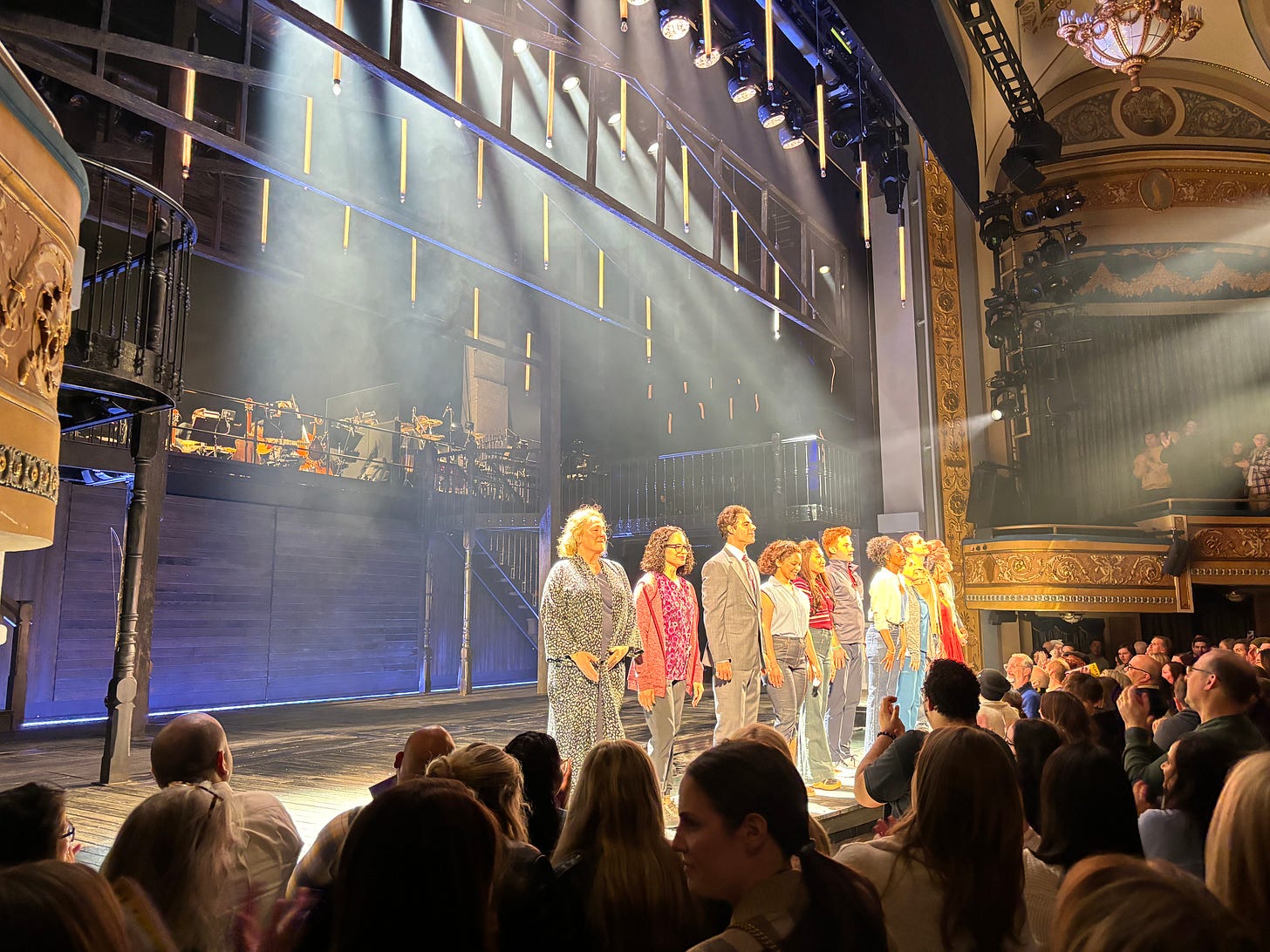NY Reviews: The two best shows of the season (so far!)
"Days of Wine and Roses" and "The Connector" (plus a quick take on "The Notebook")
Hello, play-goers! I’ve got reviews for you of two excellent musicals playing in New York right now—my favorite new shows of the season so far! I’ve also got a quick take on the new musical “The Notebook.”
Before we delve in, a quick note to my DC readers: don’t miss the small-but-mighty Keegan Theatre’s intimate, excellent production of the great Sondheim musical “Merrily We Roll Along,” playing through March 10.
“Days of Wine and Roses”
The new musical “Days of Wine and Roses”—by far the best I’ve seen this season—is a gorgeous, heartbreaking drama about a family devastated by alcoholism. The show’s elements meld into the sublime: an elegant book by Craig Lucas, beautiful music by Adam Guettel, assured direction by Michael Greif, and top-of-their-game performances from Kelli O’Hara and Brian D’Arcy James. The show fizzes bright and then socks you in the stomach with the tragedy wrought on its central characters.
In 1950s New York City, public relations worker Joe (D’Arcy James) meets Kirsten (O’Hara), a secretary at the company, at a work event on a boat. Water is a theme throughout, with innovative set design from Lizzie Clachan that includes a well of water running the length of the front of the stage, reflected upwards by Ben Stanton’s moody lighting design. Joe buys Kirsten her first alcoholic drink ever, starting them both down a path of co-dependent alcoholism. The story moves effortlessly through time, as they move in together, marry, and have a daughter.
What makes the production compelling is the way the central conflict—the characters versus their alcohol abuse—so subtly develops. It’s a quiet struggle, devoid of manufactured histrionics. You are immediately invested in the characters and find yourself shouting “No! Don’t do it!” in your head as they struggle against reaching for the glass. Kirsten’s descent is particularly heartbreaking. She starts full of wonder at the world, reciting facts from an encyclopedia by memory. Yet even at the top, she knows she’s attracted to danger, conveyed through mysterious lyrics from Guettel:
Abandoned buildings and jagged cliffs / Newborn stars and hieroglyphs / Some things I can’t ignore / I can’t ask why, what for / I love a bolted door / Let me in there, let me see / … Danger, hazard make me happy
In a Tony-worthy performance, O’Hara brings out the complexity of her character through understated acting and heavenly vocals that reveal a profound depth of feeling. D’Arcy James is a perfect counterpart, giving his character the requisite frothiness at the beginning, despair in the middle as his drinking starts costing him, and then redemption as he joins AA and makes an earnest attempt to get better. Throughout, he reveals glimpses of Joe’s trauma of being orphaned and serving in the Korean war. The two actors together are a knock-out.
Guettel’s jazzy, classical-adjacent score is structurally inventive, employing motifs more than repeated melodies. This style of music suits the mid-century setting and the aching emotional tenor of the story. Generous use of reeds and xylophone give it a sound unlike anything else you’ll find on Broadway today, with unexpected instrumental counterpoints to the singing. The most memorable repeated phrase is a simple four note, rising theme on piano and flute, which appears in three songs (including the strongest number, "Forgiveness"). Guettel’s lyrics are a delight; here’s one example of many, in the upbeat drinking song “Evanesce”: “We’re alive / We’re alive / Let’s contrive / To convive.” Brilliant!

As the characters’ lives fray and fall apart, Clachan’s set design mirrors their experience. The curtains in their apartment start clean and new, only to be torn and dirty in the next scene. Greif’s direction places faith in the material, offering clarity without being overly literal. For example, at a low moment for Kirsten, she lies down and runs her hand through the water. Moments like these don’t make any factual sense—she doesn’t have a trough of water in her apartment!—but work completely in terms of deepening the storytelling. Kai Harada’s sound design makes each word crystal clear and brings in the city’s soundscape.
This musical may not appeal to all playgoers given its non-pop score and tight focus on a family. But to this viewer, its focus on ordinary people grasping for redemption and the heartbreak that follows made for a powerful story.
Playing on Broadway at Studio 54 through April 28
“The Connector”
The man cannot write a bad song! That was my recurring thought as my toe tapped along to Jason Robert Brown’s grab-you-and-pull-you-in score to “The Connector,” running off-Broadway at MCC Theater in a terrific world premiere. Especially thrilling is the absolute banger “The Western Wall”—a true eleven o’clock number. I put good odds on the show transferring to Broadway.

It’s 1997 and the magazine The Connector (an obvious stand-in for The New Yorker) is celebrating fifty years as a leading outlet for thought-provoking journalism. The over-empowered Ethan Dobson (Ben Levi Ross) is straight, white, male, and freshly Ivy League degree-d. Ethan’s wanted to write for the magazine all his life and impresses editor Conrad O’Brien (a great Scott Bakula), who sees himself in this young upstart and gives Ethan a job. The young reporter scores article after article in the magazine, while his colleague, copy editor Robin Martinez, can’t get anything published. (Robin is played by Hannah Cruz, though at my performance I saw the excellent understudy Ashley Pérez Flanagan, whose adoring family sat next to me!) Ethan and Robin’s friendship and rivalry form the initial driving conflict of the show, which progresses to take on much broader issues when Ethan’s work is accused of being fictionalized.
One of the many strengths of the excellent book by Jonathan Marc Sherman is that it doesn’t flatten the story into a hackneyed identity-based conflict: white guy versus Latina woman. Instead, the production realizes them as fully formed individuals. Truly a plot-driven show, with very little fat to trim, all the pieces connect into a powerful climax. And it was consistently laugh-out-loud funny!
Brown has written some of my favorite scores of the last twenty-five years: “Parade,” “The Last Five Years,” and “The Bridges of Madison County.” All deliver strong melodies driven by piano and guitar. He is particularly gifted at the “story song,” which tells a sweeping tale in just one number. He makes great use of this here, with three numbers tied to Ethan’s articles. Musically, they match up to the magazine’s stories: a hip-hop adjacent number for an underground figure revealing a mayor’s bad deeds and a klezmer and middle eastern sound for “The Western Wall.”
That number is seared in my memory—the very best of what musical theatre has to offer. Ethan is increasingly unhinged as he senses he might be in trouble; this permeates the music and choreography (from Karla Puno Garcia). It builds and builds, with powerful orchestrations (also by Brown) and gorgeous orange-toned lighting from Jeanette Oi-Suk Yew that evokes Jerusalem’s old city.
Ethan is an anti-hero in the mold of Evan Hansen. Levi Ross previously played that role, too; here, as Ethan, he brings a clarion voice, goofy confidence, and total obliviousness to his character’s own privilege. The whole ensemble is very strong, especially Mylinda Hull, who gives her character Mona Bland (a fan who frequently writes in to the editor with corrections) just the right mix of fan-girl, frumpiness, and, when her letters are not answered, woundedness. Another standout is Jessica Molaskey, playing the magazine’s fact-checker Muriel with intensity and precision.
Director Daisy Prince makes great use of the Newman Mills Theater’s very wide stage, deftly moving her ensemble around it. The design elements lean into the print media aspect of the show to great effect. Beowulf Boritt’s set design includes banker boxes and stacks of paper offstage. A dramatic backdrop of magazine proofs interacts cleverly with Oi-Suk Yew’s projections, at one point becoming a scrabble board in a number about a scrabble player (random but excellent!) Most of the stage is bare, with in-floor lighting delineating different rooms where the action takes place. Márion Talán de la Rosa dresses the cast in grey tones, furthering the newsprint theme. Ethan’s over-sized button-down shirt and loafers nicely captures the character’s nerdiness.
Brown is having a bit of a moment the last few years: he scored “Mr. Saturday Night” two seasons ago, saw a terrific revival of his “Parade” last season, and has another new work premiering later this year: “Midnight in the Garden of Good and Evil,” with a book by the incomparable Taylor Mac. I’ll be traveling to Chicago to see it and will report back!
The marketing of the show has focused on the fact-versus-fiction themes it brings out: how much journalistic license is okay? When does it cross over into fabrication? How does the media distort reality? In lesser hands, these would be too dry for a musical. But “The Connector” brings them to life through flesh-and-blood characters who embody the ideas gracefully.
Playing at the MCC Theater through March 17
Final Note on “The Notebook”
Given my aversion to popular movies being turned into musicals, I didn’t expect to enjoy “The Notebook” so much. But reader, I wept! Since I saw the show in previews, I won’t write a full review. (Plays continue to change before opening night; only then is the press is invited to review it.) Suffice it to say, it was very good.
The show is an adaptation of the novel by Nicholas Sparks, which was also turned into a film you’ve probably seen. Pop singer-songwriter Ingrid Michaelson delivers a genuinely good score and the performances are strong. Besides the beautiful love story, I liked the way Schele Williams’s and Michael Greif’s direction manages to comment on how we remember our younger selves. Three actors play each of the main characters at different points in their life. This allows for many moments where they observe their younger selves on stage, making great use of the theatrical art form to tell the story in an interesting way.
And since I know you’re wondering: the famous scene where the couple kisses in the rain is absolutely stunning. Ben Stanton’s vivid blue lighting lit up the rain brilliantly, while the coastal, wood-forward scenic design is from David Zinn and Bret J. Banakis.
That’s all for now! Hit “reply” to this email or reach out via Substack to let me what you’ve seen lately or your reactions to these shows!

